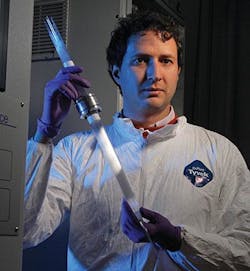Microscopic laser beam promises no-needle blood draws

NoNeedles Venipuncture (Altamonte Springs, FL) is working on addressing the common fear of needles (called trypanophobia) with the research backing of Dr. Rodrigo Amezcua Correa, assistant professor of optics at the University of Central Florida. Thanks to the Florida High Tech Corridor Council’s Matching Grants Research Program, they are developing a process that uses laser pulses to painlessly draw blood without using a needle, which could have a major impact on the medical field with a particular focus on pediatrics.
RELATED ARTICLE: Commercial smartphone software to use hand vein patterns for authentication
Needle-phobia is one of the most common fears, and drawing blood is one of the most ubiquitous medical procedures that nearly everyone faces at some point in their lives. The NoNeedles process uses a laser beam that is fired through the skin in one quadrillionth of a second to create a microscopic channel into the vein. The bloodstream is then connected to a port to collect the blood sample before a laser is fired again to seal the channel and stop the bleeding. The result is a quick, accurate and painless procedure for collecting blood.
"Our design of this instrument is intended to improve the process of performing a venipuncture--such that the quality will be better and the cost will be lower," said Calvin Wiese, president of NoNeedles Venipuncture.
"What excites me most about this project is to see the vast potential of lasers. Every day you see more applications," said Amezcua Correa. "If you can use lasers to cure some medical conditions or make common procedures easier, that's very exciting to me."
NoNeedles Venipuncture's process also represents a vast improvement over current laser tissue methods, such as those used in laser tattoo removal, which require a large laser pulse that uses a lot of energy and often burns patients’ skin. In addition to the obvious benefits of eliminating pain and the "scare factor" many patients experience, a needleless system would also provide a much lower risk of contamination from blood-borne pathogens.
Initial results have been promising and the team hopes to complete additional studies on real human or animal tissue as the next step toward meeting their research goals.
"The money we've received from the Florida High Tech Corridor Council has helped us a lot in our research efforts," said Amezcua Correa. "We've been able to build a research group and bring students on board to support our efforts."
SOURCE: Florida High Tech 2014; page 22 of http://www.floridahightech.com/publication/magazine/fht2014.pdf
About the Author

Gail Overton
Senior Editor (2004-2020)
Gail has more than 30 years of engineering, marketing, product management, and editorial experience in the photonics and optical communications industry. Before joining the staff at Laser Focus World in 2004, she held many product management and product marketing roles in the fiber-optics industry, most notably at Hughes (El Segundo, CA), GTE Labs (Waltham, MA), Corning (Corning, NY), Photon Kinetics (Beaverton, OR), and Newport Corporation (Irvine, CA). During her marketing career, Gail published articles in WDM Solutions and Sensors magazine and traveled internationally to conduct product and sales training. Gail received her BS degree in physics, with an emphasis in optics, from San Diego State University in San Diego, CA in May 1986.